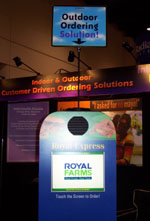Article
Kiosks by any definition
From modified ATMs to self-serve checkouts and fast-food menus, kiosks have a future in the convenience store industry, as evidenced at the recent National Association of Convenience Stores exhibition.
October 13, 2002
ORLANDO, Fla. -- The role of the kiosk in convenience stores may depend on your definition of a kiosk.
If you lean toward a definition that includes any self-service device, then it was easy to find
What do you think? Which applications will be most successful at gaining entry into the convenience store industry? Self-serve checkouts Vote in our Oct. 11 e-mail news alert. If you haven't yet signed up for the news alerts, click here. |
If your definition of kiosk includes ATMs, consider that 77.4 percent of the 124,500 U.S. convenience stores have an ATM, according to NACS. Changes in the configurations of those ATMs have the potential to drive revenue for c-store owners and providers in the near future.
If your definition includes self-serve checkouts, there's an engaging battle shaping up between Optimal Robotics and NCR Corp.
 |
Several companies, including Interactive Kiosks, which designed this outdoor model, are developing self-serve kiosks for fast-food restaurants, including drive-thrus. |
And finally, if your definition includes self-service menu devices, then the emergence of new technology threatens to change the face of food service.
Checking out: The growth of self-serve checkouts, in such retail chains as Kroger and Kmart, serves as reason for hope at NCR and Optimal Robotics, the technology leaders in the checkout space.
In groceries, self-checkout lagged for years before taking off three years ago, according to Ilan Toledano of Optimal Robotics' operations department. His company's newest feature is a biometric device that records fingerprints so that individuals buying beer and cigarettes can skip the age-approval process after their prints are on file.
He said the U-Scan machines made by Optimal Robotics are operating in 3,000 retail stores with more than 16,000 terminals.
Kevin Ellis, FastLane specialist for NCR, said reducing the footprint for the machines is the primary factor holding back c-store owners, and that another generation of development may help solve that problem.
"In the next year or two years, you'll see significant rollouts because people will start demanding it," Ellis said. "The interest level is there now."
Next from NCR: The Dayton, Ohio-based ATM manufacturer is building its kiosk business through applications in the bill payment and gift registry spaces, with a new stored value card set for a major upcoming rollout.
Bob Brower, director of Web Kiosk Solutions sales, said that sales of bill payment kiosks to cellular phone providers have taken off recently. With 250 new kiosks scheduled for delivery to Sprint, Cingular and Verizon in the next month, more than 1,600 bill payment kiosks from NCR will be in place.
Can I take your order: Also at NCR, kiosks for food-service applications were on display. Mike Zweber, NCR Web Kiosk Solutions director of product and solution marketing, envisions plenty of growth in that sector.
"I think three to five years from now, it's going to be everywhere," he said.
Zweber demonstrated a gift card kiosk, currently in a four-store pilot for an unnamed major retailer, that assigns the value of the customer's choice to cards that the customer swipes on the machines.
 |
Thanks to Intermedia Kiosks' self-serve menu kiosks, fast-food customers can place their orders without talking to anyone behind the counter. |
Have it your way: Intermedia Kiosks, a software developer based in Maryland, has developed a kiosk for Burger King that will soon launch in a 17-store test. There is an outdoor version for drive-thrus and one that sits on the counter inside. David Henry, vice president of business development, said the kiosk has enormous potential.
"People don't enjoy talking to the person at the counter," he said. He added that customers prefer controlling the ordering process and are likely to upsize their orders on the kiosk. The kiosk accepts cash and credit cards, so employees don't have to handle payment.
Henry said that Arby's and KFC have shown interest in the technology.
Reader Response...
I enjoyed your insights from attendance at NACS and agree with your initial assessment that kiosk deployments, particularly in a c-store environment, have largely been misguided. Formerly with the failed Next Generation Network, which placed digital screens primarily in c-stores to advertise to and entertain customers waiting in line, I became intimately aware of operational and other issues which pertain to these avenues.
C-stores have floor, wall, and counter space concerns as virtually every available square inch is dedicated to the display of merchandise. It is not unusual for a small counter display of candy, for example, to generate $300-$500 in revenue per month to the store. It is unreasonable for a c-store operator to allocate significant space to a kiosk or other device with a dubious or non-existent revenue potential.
Furthermore, c-store employees must be constantly vigilant to observe goings-on in the store to deter theft, vandalism, and other mischief. If the kiosk or other device compromises or otherwise blocks the employees' view of on-going activities in the store, it is a problem. Also, if the kiosk functionality is such that it becomes an attractive nuisance which encourages loiterers or other "undesirables" on the premises, the employee has the additional burden of "watching" these individuals.
Frankly, c-stores require fast turn-around (in and out) of customers and don't want people lingering. Kiosks, or other devices, which may attract unwanted attention can be counter-productive in these environments. Do you really want some of the people who are apt to use these platforms around? Think about it.
Bill Ryan
Dana Point, Calif.







